Why not try this unique twist on the classic Hot Cross Buns with this recipe for Vegemite and Cheese Hot Cross Buns! These buns are packed with flavour, featuring a savoury combination of Vegemite and Parmesan cheese and a perfect soft and fluffy texture. They are also made lactose-free and are perfect for Easter brunch or any time you want a delicious savoury treat.
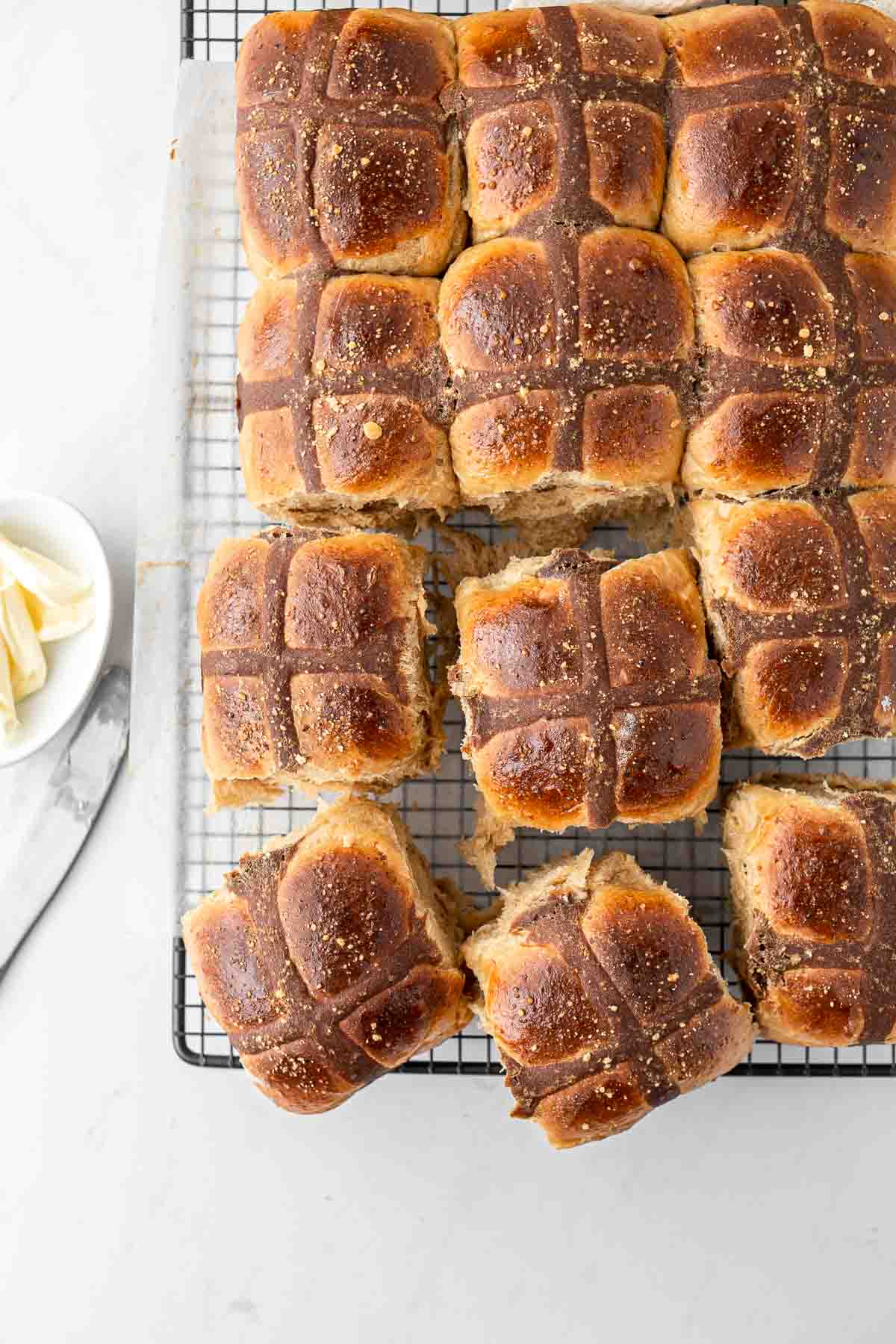
Each year as soon as Christmas is over, there is uproar as the supermarket starts stocking everyone’s favourite Easter treat, the hot cross bun. These sweet and soft baked buns are filled with warming spices, fruit (or no fruit if you’re so inclined), or even chocolate.
But what about options for those people who prefer a little savoury over sweet?
That is exactly where this recipe comes in. Supermarkets are now stocking the Aussie classic flavour combination of vegemite and cheese in hot cross bun form and I’ve been dying to try them. But alas, due to my dietary needs I am unable to eat them so I’ve had to settle by creating my own recipe instead!
This recipe is not dairy free as we are using real parmesan, but it is lactose free (I’ll go into this more in the FAQs section later in this post) however you can choose to make it completely dairy free by swapping out the cheese for a dairy free alternative or omitting it altogether if necessary.
Making homemade hot cross buns might sound a little bit intimidating but I promise you it’s actually quite easy once you understand the process. You will need a little patience as these buns call for two rises but if you take your time and enjoy the process there really is nothing that even comes close to how much better homemade bread tastes.

Key Ingredients
To make these savoury hot cross buns you’re going to need a few key ingredients that you would expect when making bread at home.
- Yeast – the key to any bread recipe, yeast helps the dough to rise and create a beautifully soft texture.
- White sugar – helps feed the yeast.
- Dairy free milk – keeping this dough rich and lactose free I use oat milk for the best results but you can use your favourite.
- Plain flour – also known as all purpose flour in the US. You could also use bread flour.
- Vegemite – this iconic Australian ingredient is a savoury spread made from yeast extract that adds a unique flavour to these hot cross buns and pairs well with the cheese.
- Dairy-free butter – to keep this recipe lactose free we use a dairy free butter substitute such as Nuttelex to give the dough the richness that you expect from a hot cross bun.
- Egg – again adding richness, helping to bind the ingredients together giving the buns structure while also keeping them super soft and light.
- Parmesan cheese – you want to make sure to use a good quality Parmigiano-Reggiano that has been aged more than 12 months to keep this recipe lactose free. More information in the FAQs.

Step-By-Step Instructions
To make these delicious vegemite and cheese hot cross buns, you’ll need a few key tools. Firstly you’ll need a stand mixer. Technically you could try and make these in a large bowl and knead by hand but that is going to require a lot of patience and muscle so I definitely recommend using a stand mixer with a dough hook attachment to make this whole process much easier.
You’ll also need a 9 x 13 inch (20cm x 30cm) baking pan that has been lined with baking paper. A pastry brush, wire cooking rack, piping bag or ziplock bag, and some kitchen scales are also going to come in handy.
This recipe seems long, and it will take around 3 hours to complete but there is a lot of down time while you wait for the dough to rise so don’t be too intimidated, read through the recipe thoroughly before starting so you know what to expect and take your time and enjoy the process.
To make these savoury hot cross buns, you’ll first need to combine the yeast, white sugar, and warm dairy-free milk in the bowl of your stand mixer. Stir until the yeast is dissolved, then cover with a clean tea towel and let it sit for 5-10 minutes or until it becomes frothy. You’ll know it is ready when the top looks foamy and it has a strong bready smell.
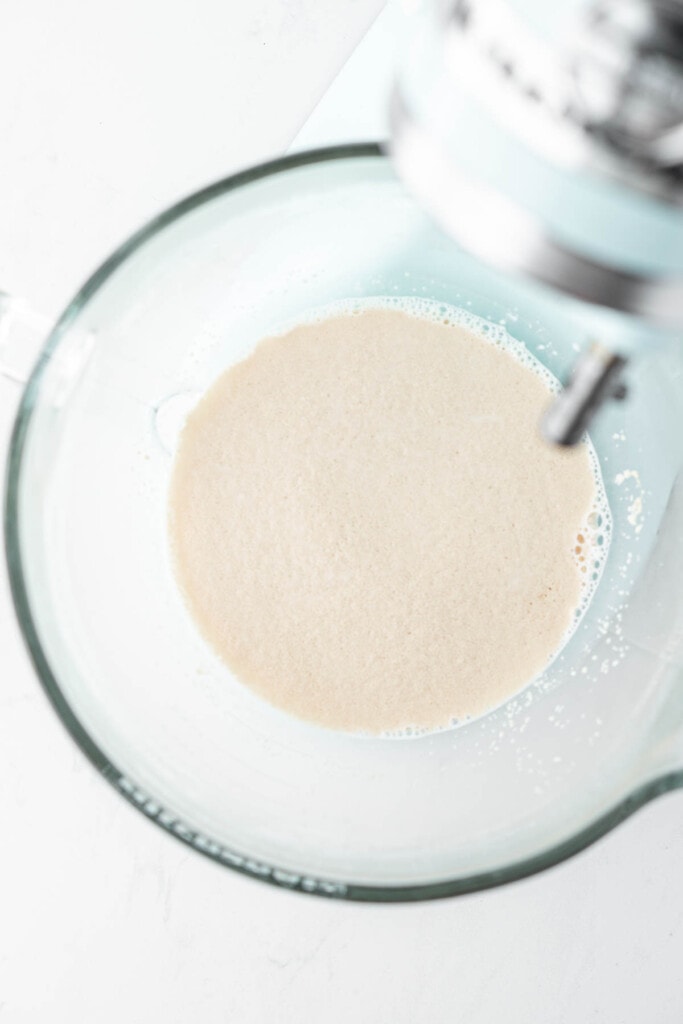

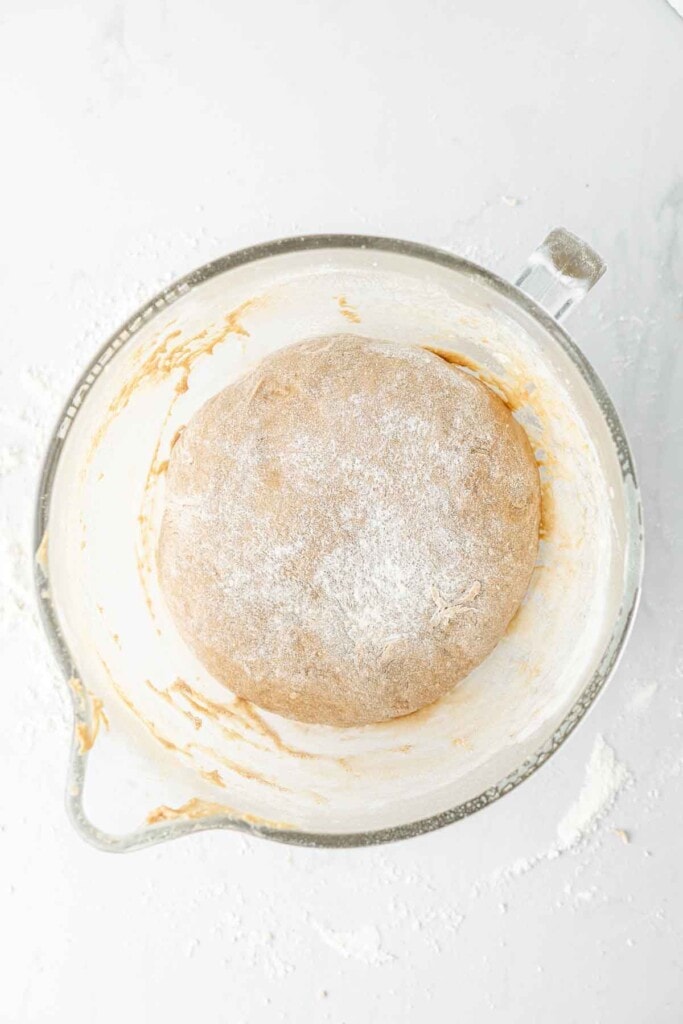

Add in 2 cups of the plain flour and start mixing on low using the dough hook attachment of your stand mixer.
Next, add another cup of flour, the dairy-free butter, egg, and vegemite, and mix on medium/low speed until the dough starts to form. You want to make sure your egg and dairy free butter are room temperature and not cold from the fridge as this will help the ingredients combine in the dough.
Add in the remaining flour and parmesan cheese and mix until the dough starts to pull away from the sides of the bowl. It will still be sticky, but that is ok!
When needing the dough with the stand mixer you want to make sure to always be mixing at a lower speed.
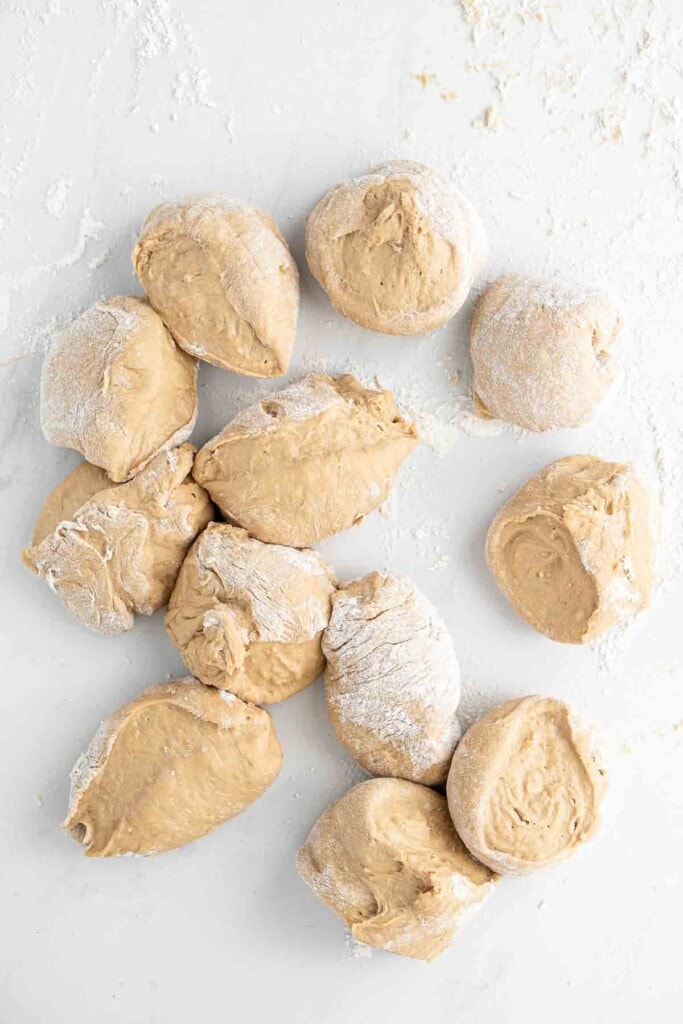

Turn the dough out onto a well-floured surface and knead with floured hands for 5-10 minutes or until it becomes smooth and elastic. Gently shape the dough into a ball and place it back into the bowl that has been greased with oil. Cover it with a tea towel and let it rise in a warm, draught-free place for 1 hour or until it has doubled in size.
Once the dough has risen, punch it down to release the air, then turn it out onto a floured surface and shape it into a ball. Cut the dough ball into 4 even pieces, and then cut each piece into 3 so that you have 12 pieces in total. Roll each piece into a ball and place them evenly into the pan.
Cover again with the kitchen towel and set aside in a warm place for 20 minutes.



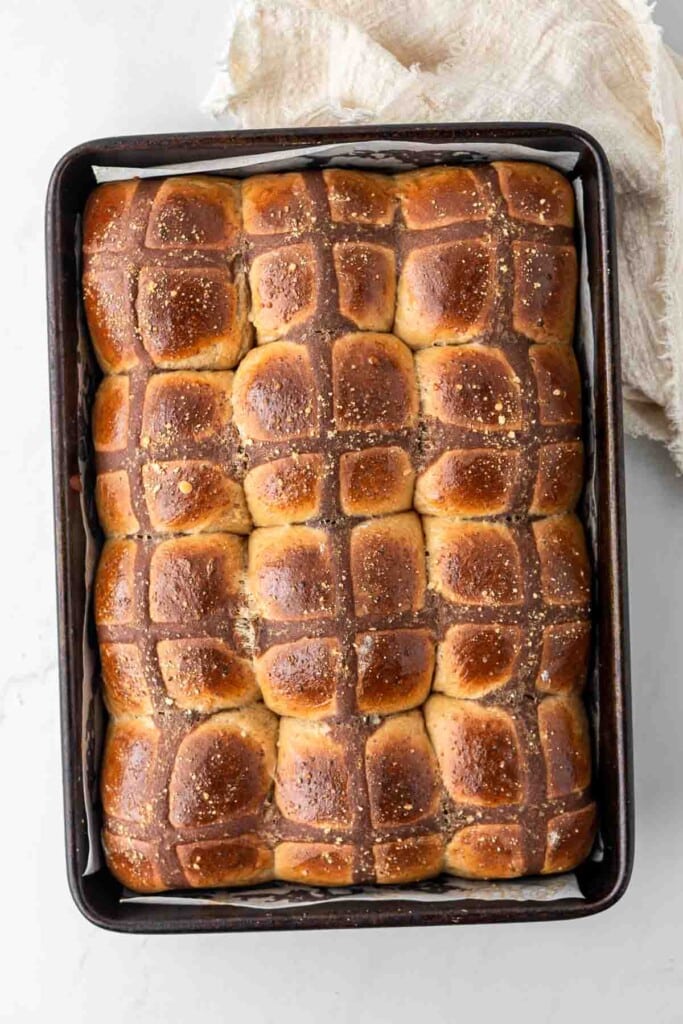
Before the second rise is complete, preheat the oven to 180°C. Mix together the additional plain flour, water, and vegemite to make a thick paste. Brush the tops of the buns with the beaten egg yolk. Place the paste into a ziplock bag and snip off the end. Once the buns have finished rising, pipe crosses onto each using the vegemite paste and sprinkle over a little extra grated parmesan cheese.
Place the buns in the oven for 30 minutes, or until they are browned on top and they make a hollow sound when you tap the top. Let the buns cool on a wire rack before serving warm with dairy-free butter. Yum!

Recipe FAQs
Parmesan cheese, especially Parmigiano-Reggiano produced in Italy, is usually safe to consume by people with lactose intolerance as long as it has aged for at least 12 months due to the cheese-making process.
What happens is that the lactose is converted into lactic acid, which is then drained off with the whey. This means that even though Parmesan is made from cow’s milk, it contains only trace amounts of lactose and can be safely consumed by people with lactose intolerance.
The production of Parmigiano-Reggiano in Italy is tightly regulated and must adhere to strict guidelines to ensure quality and authenticity. One of these guidelines is that the cheese must be aged for a minimum of 12 months, with many producers choosing to age their cheese for much longer to develop a richer flavour.
Therefore, I always buy Parmigiano-Reggiano produced in Italy so I know it’s gone through this strict process and will be safe for me to consume.
Like most homemade bread, these are best enjoyed while still warm fresh from the oven. They will store for around 2 days before starting to get a bit stale, however if you need them to last longer they can be frozen for up to 3 months as long as wrapped well in plastic wrap.
They are best served warm either heated up slightly in the microwave or gently toasted (my favourite) and you can simply add a little bit of dairy-free butter, or you can add a fried egg with a soft yolk into the middle for an epic Easter breakfast sandwich.
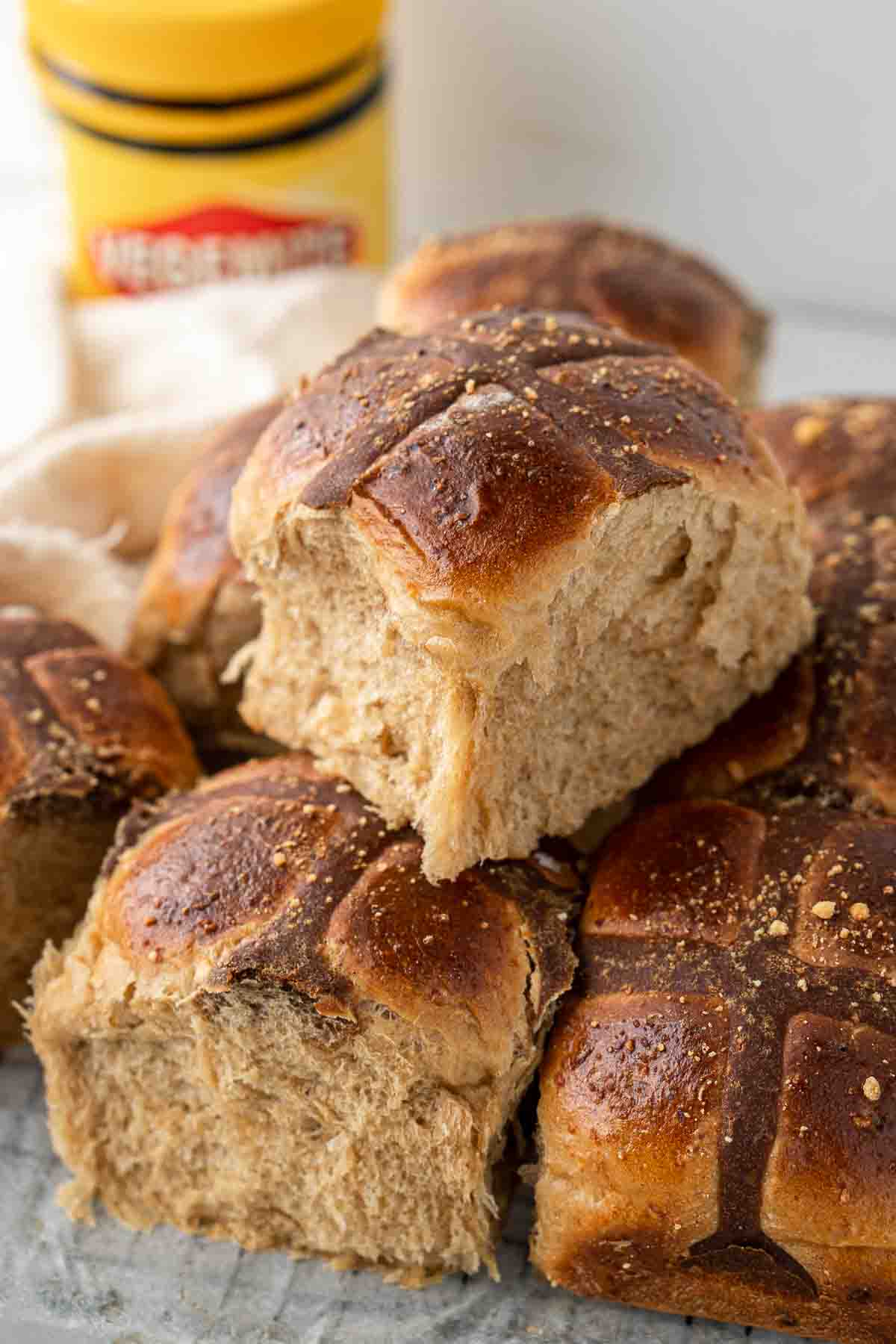
More Hot Cross Bun Recipes for Easter:
Classic Hot Cross Buns
Chai Spiced Hot Crossed Buns (Fruit-Free)
Chocolate Hot Cross Buns

Vegemite and Cheese Hot Cross Buns
Ingredients
- 2 ¼ teaspoons or 1 x 7 gram packet yeast
- 1 tablespoon white sugar
- 1 ½ cups dairy-free milk warmed
- 4 ¼ cups plain flour
- ¼ cup vegemite
- ¼ cup (60 grams) dairy-free butter
- 1 egg room temperature
- ¾ cup parmesan cheese grated
For the crosses:
- 4 tablespoons plain flour
- 4 tablespoons water
- 1 tablespoon vegemite
- ½ tablespoon parmesan grated
- egg yolk beaten
Instructions
- In a large mixing bowl, combine the yeast, sugar and warmed milk. Stir until the yeast is dissolved and let it sit for 5-10 minutes or until it becomes frothy.
- Add in 2 cups of the flour and begin to mix on low using the dough hook attachment of your stand mixer. Add another cup of flour, the dairy-free butter, egg and vegemite and mix on medium/low speed until the dough starts to form. Add in the remainder of the flour and the parmesan and mix until the dough starts to pull away from the sides of the bowl. The dough will still be quite sticky.
- Turn the dough out onto a well floured surface and knead with floured hands for 5-10 minutes or until it becomes smooth and elastic. Gently shape the dough into a ball.
- Place the dough ball back into the bowl that has been greased with oil and cover it with a tea towel. Leave it to rise in a warm, draught-free place for 1 hour or until it has doubled in size.
- Punch down the dough to release the air and turn the dough out onto a floured surface and shape the dough into a ball.
- Line a 9 x 13 inch (20cm x 30cm) tray with baking paper and set aside. Cut the dough ball into 4 even pieces, and then cut each piece into 3 so that you have 12 pieces in total. Roll each piece into a ball and place evenly into the pan. Cover again with the kitchen towel and set aside in a warm place for 20 minutes.
- Before the second rise is complete, preheat the oven to 180°C. Mix together the additional flour, water and vegemite to make a thick paste. Brush the tops of the buns with the beaten egg yolk. Place the paste into a piping bag or zip lock bag and snip off the end. Once the buns have finished rising, pipe crosses onto each and sprinkle over a little extra grated parmesan cheese. Place the buns in the oven for 30 minutes, or until browned on top and they make a hollow sound when you tap the top.
- Let the buns cool on a wire rack before serving warm with dairy-free butter.
Nutrition
Nutritional information is provided as a guide only and is calculated using automated online tools, therefore we cannot guarantee the accuracy. We encourage you to make your own calculations based on the actual ingredients used in your recipe.



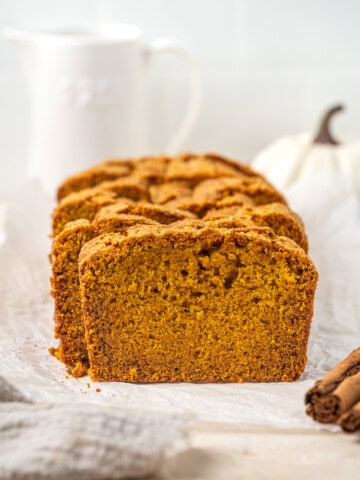

Made this recipe? Leave a review!